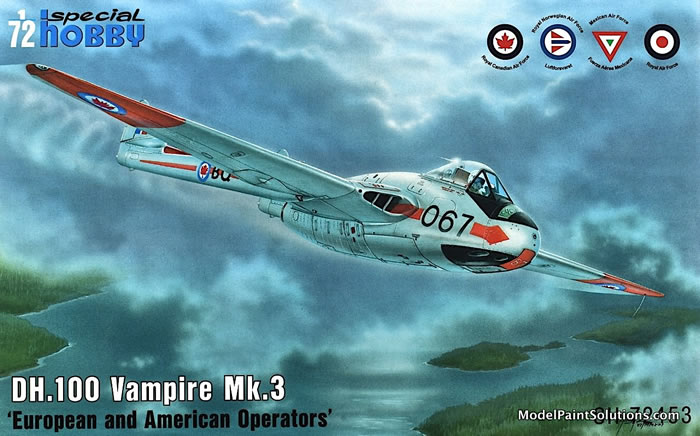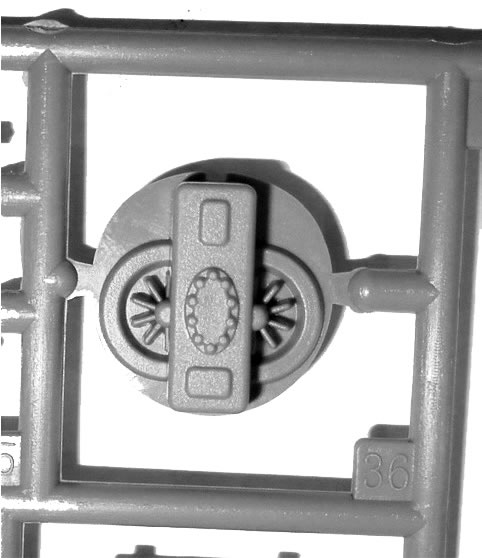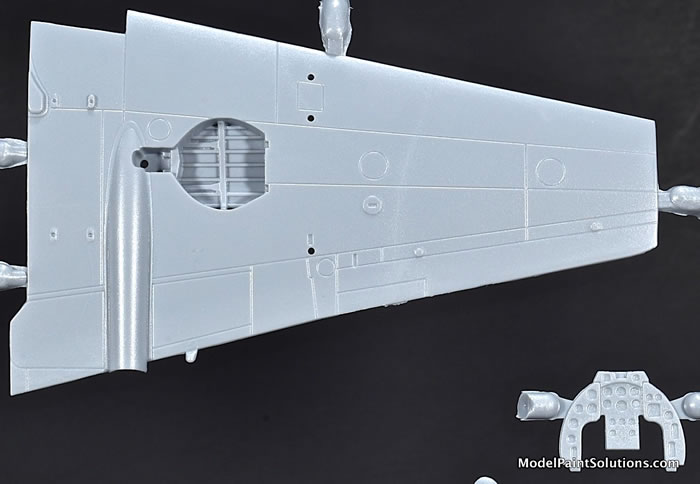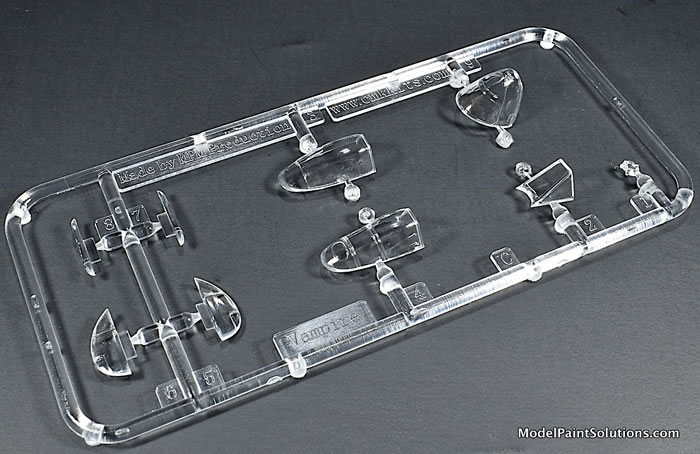DH.100 Vampire F.3
European and American Operators

Special Hobby, 1/72 scale
S
u m m a r y : |
Description and Item No.: |
Special Hobby Kit No. SH72453 - DH.100 Vampire F.3 “European and American Operators” |
Contents and Media: |
51 parts in grey styrene (not all are used), 9 in clear (not all are used), and one decal sheet with markings for 4 airframes. |
Price: |
£14.60 EU Price (£12.17 Export Price) plus shipping available online from Hannants |
Scale: |
1/72 |
Review Type: |
First Look |
Advantages: |
Very well moulded, good detailing, great instructions and decals for a range of examples. |
Disadvantages: |
Strange jet fan. |
Recommendation: |
The Vampy is my kinda girl and I look forward to spending more time with this kit. My heart is certainly with the RCAF option, but that fine Mexican lass sure is attractive. |
Reviewed by Jim Bates

The second British jet to enter service, the Vampire first flew in 1943 and just missed entering service before the wars ended. The Vampire was the first pure jet to operate from an aircraft carrier, the first jet to fly the Atlantic, and set a world altitude record in 1948.

The Royal Canadian Air Force received a handful of Gloster Meteors, mostly for cold weather testing, but the Vampire was the first jet powered fighter to enter service with the RCAF in 1948. The Vampires were built in the UK, but assembled by de Havilland Canada in Downsview. The RCAF ended up with 86 Vamps (85 F.3 Vampires and a single F.1 for Cold weather testing), which served with both front line and Auxiliary squadrons until 1956. They were replaced by Canadair built Sabres, and upon retirement, some of the remaining RCAF Vampires were sold to a US company in Wisconsin named Fliteways, Inc. It is unclear what their plan was for the old jets, but they ended up selling a few to the US civil register (Google “The Vampires of Las Vegas” for a neat story about Johnny SkyRocket and the Mystery Jet). Fifteen were sold to the Mexican Air Force which operated them until the late 1960s.
The Vampy in 1/72 scale
The first Vampire in 1/72 was issued by Frog in the early 1970s. Heller issued a much nicer Vampire FB.5 in 1979, which was nicely detailed for the time, if plagued by raised panel lines. This kit was later issued by Revell, Lodela, and Airfix. CMR issued a line of resin kits with excellent detail, but it wasn’t until 2010 that a new Vampire appeared in injected plastic. This was issued by A-Model (enough said) and then a couple of years later Dragon/Cyber-Hobby issued a very interesting kit. It featured some amazing molding, but had a cockpit that appeared to be based on one side of a Vampire T.11. The instrument panel looked more like a jukebox, the drop tanks are over-sized, and there were quite a few spurious panel lines. All other Vampire kits were rendered moot when Special Hobby issued their first Vampy in 2014. This kit has been re-boxed by Xtrakit and Revell/Germany.
As stated above, this kit was first issued in 2014, but Special Hobby have finally decided to release the kit with RCAF decals. As a bonus, Mexican, RAF Auxiliary, and Norwegian markings are included.
The kit consists of two runners of gray plastic and one of clear parts. The parts included would allow a Vampire F.3, FB.5, FB.6, and FB.9 to be built from the box, but we will focus on the RCAF Vampire F.3. All parts are crispy modeled, no flash is featured, and the panel lines are quite fine. This is a long way from early Special Hobby kits!
Construction starts with the cockpit…I feel like I’ve written that before somewhere…and is nicely detailed with a seat, stick, gunsight, instrument panel, and the odd radio box. The kit only includes a single option for a stick style control column, but the RCAF and Mexican aircraft were fitted with a spade grip; to the spares box! That said, there is sufficient detail for a cockpit that has to be painted black. Decals are provided for the instrument panel and seat harness. For the modeler’s enjoyment, two RCAF Vampire cockpit photos are included courtesy of the Department of National Defence/Library Archives of Canada (RE-4086-4 and RE-4086-5).
Something has gone quite wrong with part B36, as a pop machine has been added to the middle of the jet fan. The good news is you won’t really see it.

The fuselage pod is split into top and bottom parts, not the usual left and right halves. One nice feature are the alternate noses provided for the clear panel version used on RCAF Vampires. Airfix missed this in their recent 1/48 kit.
The wings are assembled from top and bottom halves, intakes, and then the round wingtips are added.

Again, SH has done the modeler a service molding these in clear plastic, so the landing lights can be masked off before painting. The tail booms have sturdy locators, but make sure to get these straight. Finally, the landing gear, drop tanks, and other ancillaries are added and the model is complete.
The canopy parts are crystal clear and parts are provided.

They may be posed open or closed.
Colours and Markings
The decal options are A) an RCAF aircraft from 438 “City of Montreal” Squadron with some nice red trim, B) a stunning green and yellow Mexican Vamp with a shark mouth (no wonder they called these things avocados!), C) a rather plain Royal Norwegian Air Force aircraft, and D) a 614 Royal Auxiliary Air Force example with large green and red boom bands. The decals look beautiful on the sheet and include full stencils. Special Hobby have helpfully provided cut up decals for the “RAuxAF” serials that have to be placed over the gear doors.
The Vampy is my kinda girl and I look forward to spending more time with this kit. My heart is certainly with the RCAF option, but that fine Mexican lass sure is attractive.
Cheers,
Jim
For more on this review visit Modelpaintsolutions.com.
Review Text and Images Copyright © 2022 by Model Paint Solutions
Page Created 13 Janury, 2022
Last updated
13 January, 2022
Back to HyperScale Main Page
Back to Reviews Page

|
Home
| What's New |
Features |
Gallery |
Reviews |
Reference |
Forum |
Search